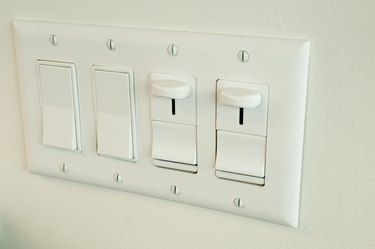
Dimmers are a great way to control the amount of light in a room, giving you the option to change the brightness throughout the day without changing the bulb. They work by reducing the electrical current or voltage that's supplied to the light. As you decrease the brightness, you also conserve energy and increase the average life span of the light. Dimmers work with many common light fixtures, but there are several things to consider before installing a switch on a new fixture.
Determine If the Light Fixture Is Dimmable
Video of the Day
Most light fixtures, including the traditional halogen and incandescent, will work with a standard dimmer switch, including both LEDs and compact fluorescents (CFLs). If you've chosen to switch your recessed can lights or track lighting to LEDs and CFLs to reduce your electrical costs, adding a dimmer will reduce them further.
Video of the Day
Choose the Correct Bulbs
Before selecting a dimmer switch for your LEDs or CFLs, make sure you have the proper type of bulb. There are a variety of LED bulbs available, including: a-style, decorative, MR16 and reflectors. CFLs also provide several choices, such as the spiral shape, R20, R30 and R40.
However, because LEDs and CFLs work differently, they often require different technology. For these, it's always best to purchase dimmers that state they're compatible with your bulbs. Additionally, check the load rating – if you have a fixture with several bulbs, you'll need to make sure the dimmer can handle that load. For example, if your fixture has 10 60-watt bulbs, you'll need a dimmer with a 600-watt max, but if your fixture only has five 60 watt bulbs, then a 300-watt max switch will work. Don't purchase a dimmer higher than about 25 percent of the rated load.
Line- or Low-Voltage Compatibility
Before you select your switch, determine if your fixture uses line or low voltage. Line voltage means that your lighting is using the line voltage in your home. Low voltage uses a transmitter to significantly lower the voltage of electricity. If your track and rail lights were installed with line voltage and incandescent bulbs, select a line-voltage dimmer, as a low-voltage dimmer won't work. For low voltage, there are two types of dimmers – magnetic and electronic. Different fixtures will require different dimmers, so check your voltage requirements before your purchase your switch.
Select a Dimmer Based on Your Needs
There are three options when it comes to dimmer switches: single pole, 3-way and multi-location. Single poles are specifically for light fixtures that only have one switch. A 3-way should be used when one light has several switches but dimming is only needed on one switch. If you have a fixture with switches in multiple locations – such as the top and bottom of a staircase – and would like to dim the lights from all locations, use a multi-location dimmer. There are also specialized switches available with enhanced features, such as tap screens.
Dimmer Switch Styles
With different styles to choose from, switch choices make it easy to select an option that matches your personal preferences.
- A toggle and slide provides a toggle to turn your fixture on and off and a small slider on the side to control the brightness.
- If you have decorative wall plates, a paddle and slide switch is often used. This features a large paddle button to turn the lights on and off and a slider on the side to control the brightness.
- For those who prefer to flip their switch, a rocker and slide offers a large slider for dimming and a smaller on-and-off rocker switch underneath.
- A rotary dial is another option to control brightness, with the lowest setting either turning the light off or to very low, depending on the type of bulb.
- For a table lamp, a plug-in dimmer switch is placed into an electrical outlet instead of being permanently installed.
- Wireless dimming switches are also available and are useful if you want to control your lights from far away. These products range in features as some can only be used if you're in the same room while others can be controlled by remote access. Depending on the product and your smart-home system, you may even be able to dim or turn on/off lights while on vacation.